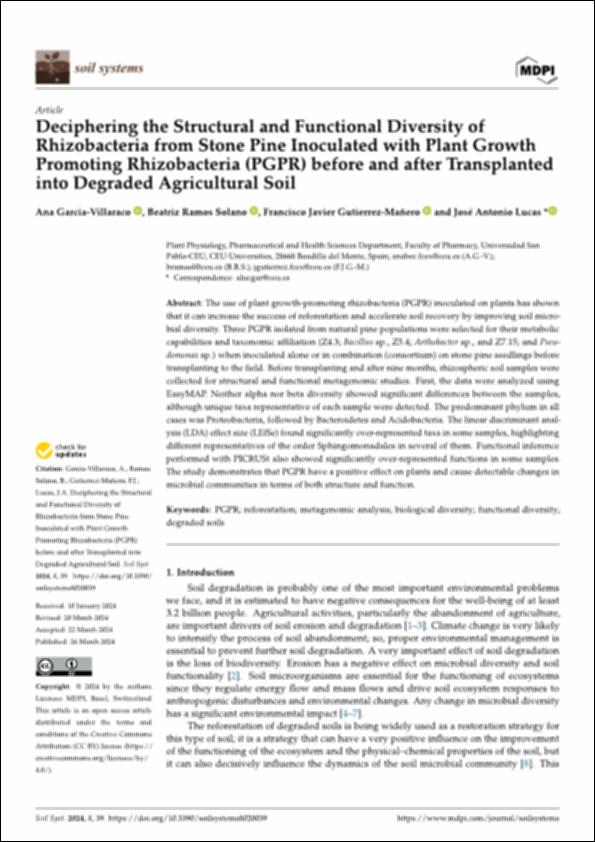Please use this identifier to cite or link to this item:
http://hdl.handle.net/10637/15879Deciphering the Structural and Functional Diversity of Rhizobacteria from Stone Pine Inoculated with Plant Growth Promoting Rhizobacteria (PGPR) before and after Transplanted into Degraded Agricultural Soil
| Title: | Deciphering the Structural and Functional Diversity of Rhizobacteria from Stone Pine Inoculated with Plant Growth Promoting Rhizobacteria (PGPR) before and after Transplanted into Degraded Agricultural Soil |
| Authors : | García Villaraco, Ana Ramos Solano, Beatriz Gutiérrez Mañero, Francisco Javier Lucas García, José Antonio Lucas García, José Antonio |
| Keywords: | Metagenomics; Reforestation; Degraded soils |
| Publisher: | MDPI |
| Citation: | Garcia-Villaraco, A.; Ramos Solano, B.; Gutierrez-Mañero, F.J.; Lucas, J.A. Deciphering the Structural and Functional Diversity of Rhizobacteria from Stone Pine Inoculated with Plant Growth Promoting Rhizobacteria (PGPR) before and after Transplanted into Degraded Agricultural Soil. Soil Syst. 2024, 8, 39. https://doi.org/10.3390/ soilsystems8020039 |
| Abstract: | The use of plant growth-promoting rhizobacteria (PGPR) inoculated on plants has shown that it can increase the success of reforestation and accelerate soil recovery by improving soil microbial diversity. Three PGPR isolated from natural pine populations were selected for their metabolic capabilities and taxonomic affiliation (Z4.3; Bacillus sp., Z5.4; Arthobacter sp., and Z7.15; and Pseudomonas sp.) when inoculated alone or in combination (consortium) on stone pine seedlings before transplanting to the field. Before transplanting and after nine months, rhizospheric soil samples were collected for structural and functional metagenomic studies. First, the data were analyzed using EasyMAP. Neither alpha nor beta diversity showed significant differences between the samples, although unique taxa representative of each sample were detected. The predominant phylum in all cases was Proteobacteria, followed by Bacteroidetes and Acidobacteria. The linear discriminant analysis (LDA) effect size (LEfSe) found significantly over-represented taxa in some samples, highlighting different representatives of the order Sphingomonadales in several of them. Functional inference performed with PICRUSt also showed significantly over-represented functions in some samples. The study demonstrates that PGPR have a positive effect on plants and cause detectable changes in microbial communities in terms of both structure and function. |
| Description: | Información adicional en https: //www.mdpi.com/article/10.3390/soilsystems8020039/s1 |
| URI: | http://hdl.handle.net/10637/15879 |
| Rights : | http://creativecommons.org/licenses/by-nc-nd/4.0/deed.es Open Access |
| ISSN: | 2571-8789 |
| Issue Date: | 26-Mar-2024 |
| Center : | Universidad San Pablo-CEU |
| Appears in Collections: | Facultad de Farmacia |
Items in DSpace are protected by copyright, with all rights reserved, unless otherwise indicated.


